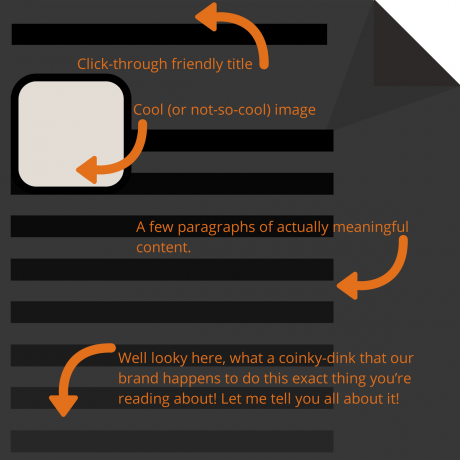Blogging is increasingly becoming a non-negotiable for brands. If you want leads, you want website traffic; if you want website traffic, you need good content. And if you want to show up in Google searches, you need good content. What is considered “good content”? That’s a huge question. But there’s one thing that I’m a stickler about: good blog content does not have sales pitches.
So What do I Consider a Sales Pitch?
This is how many blog posts come to me for editing:

My cursor, like many consumers’, almost immediately retreats to close the tab once the sales pitch begins, rendering the rest of the article useless. But this is just an example of the most offensive type of sales-y article. Forced company or product mentions have similar, if not the same, effects. Personally, the closest I’m comfortable allowing is a mid-sentence link to another, relevant, page on the website.
It’s an Understandable Want (for Brands)
It’s natural for marketers and business owners to want a brand mention in branded content. It’s what we’ve been traditionally trained to do. Many clients and past in-house employers have questioned my aversion of sales pitches in blogs. But the 67% more leads B2B companies gain from blogging aren’t coming to read sales pitches.
It was rightfully pointed out to me that it’s not always the marketers or writers who push to include sales pitches. Often, they end up there because of business owners insisting on it. But it is our job to do what’s best for the company– which includes not ruining perfectly good content. The numbers below should help give writers a solid argument to help business owners see why sales pitches are a bad idea.
It’s an Understandable Turn-Off (for Consumers)
When a consumer reads a blog, they are looking for answers, entertainment or something else valuable to them. Around 70% of consumers prefer to get to know a brand through articles instead of ads.
This statistic is even scarier:
 Source: Contently
Source: Contently
Those numbers alone should tell you not to treat your blog content like an ad—you’re not trying to make a sale, you’re trying to build trust and personify your brand.
If you need a colorful example, imagine you’re exploring online dating. Which message would you most likely respond to?
A: “I’m awesome. I’m good looking. Come over.”
B: “You like this TV show, too? Who’s your favorite character?”
Chances are B caught your attention. If you’re anything like me, the first message would be completely ignored and the second would get an enthusiastic answer in return. It’s the online dating equivalent of a soft sale that focuses on relationship building and trust.
What to do Instead
61% of consumers say they have made a purchase because of a blog post, so there’s got to be a way to do it right. Your secret weapon? Knowledge. Position your brand as a helpful resource by writing blog articles that your consumers are interested in and want to read about.
Consumers are smart. As long as the topic isn’t too far off from your product/service, they get the connection. (Side note: even if they aren’t that smart, they’re reading the content on a branded website, which essentially makes the connection for them.) The trust transfers, and with trust comes a lasting, valuable relationship.
Content marketing is a two-way street: deliver something that helps them and they’ll be happier to help you.

Leave a Reply